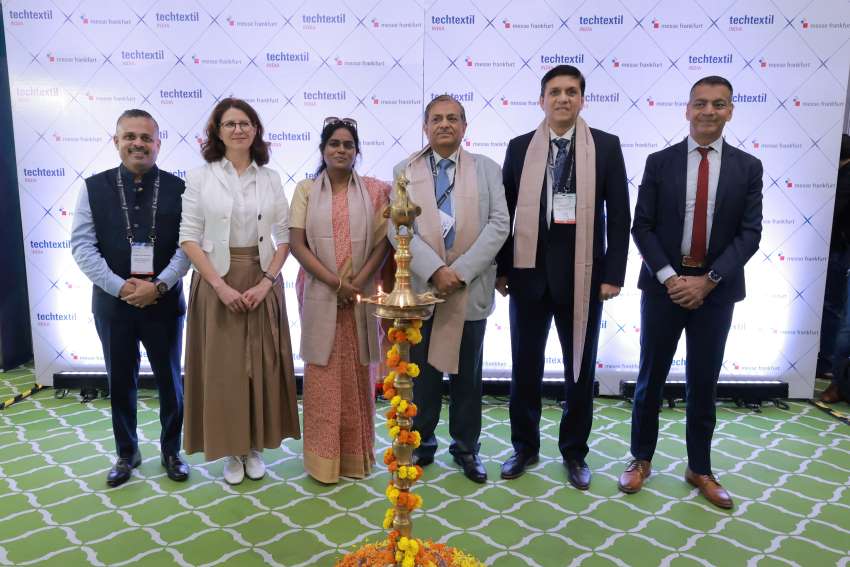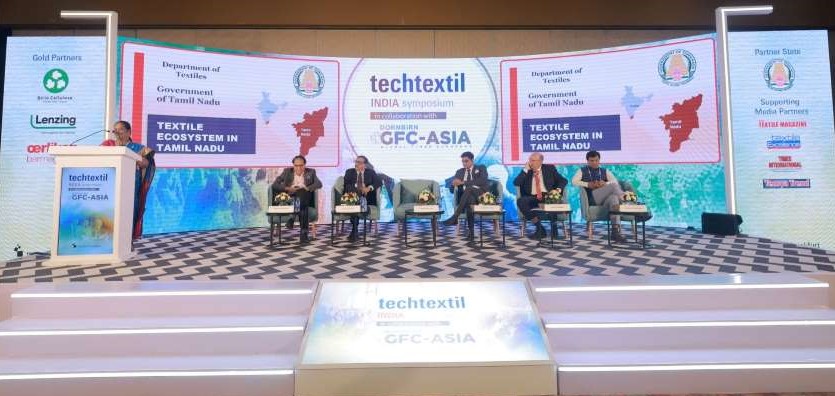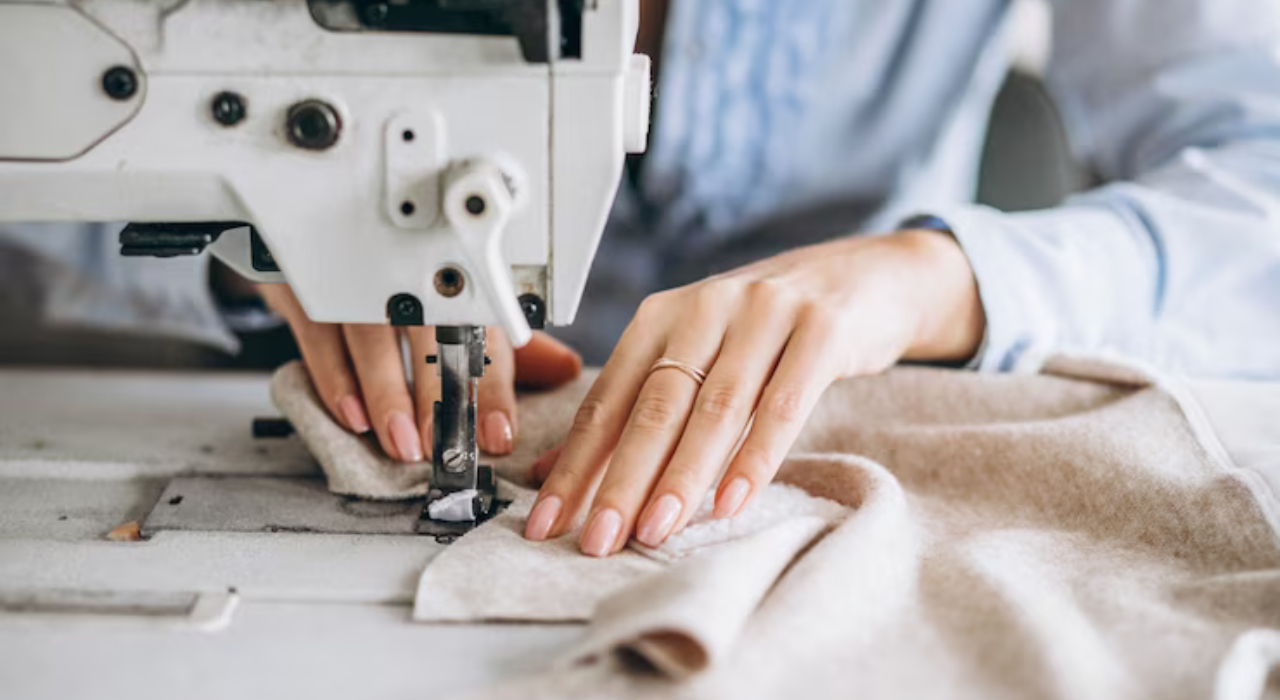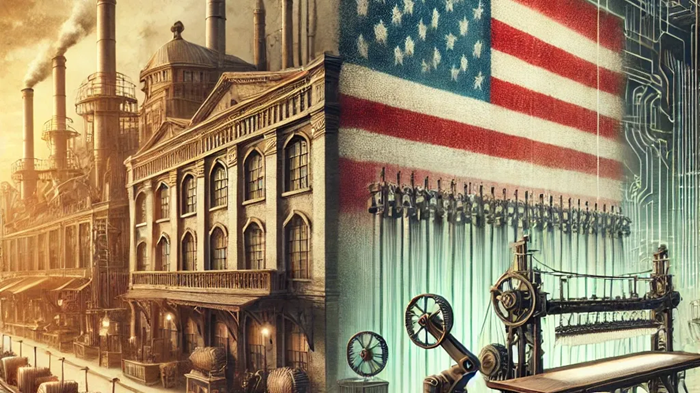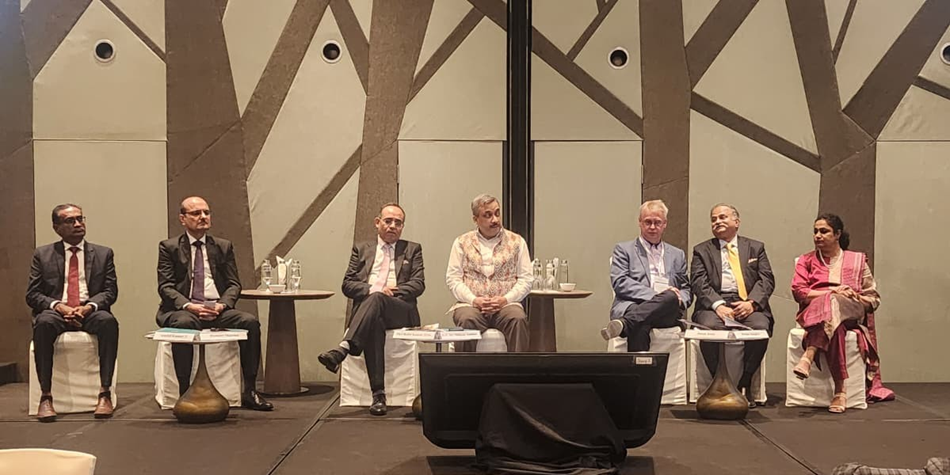FW
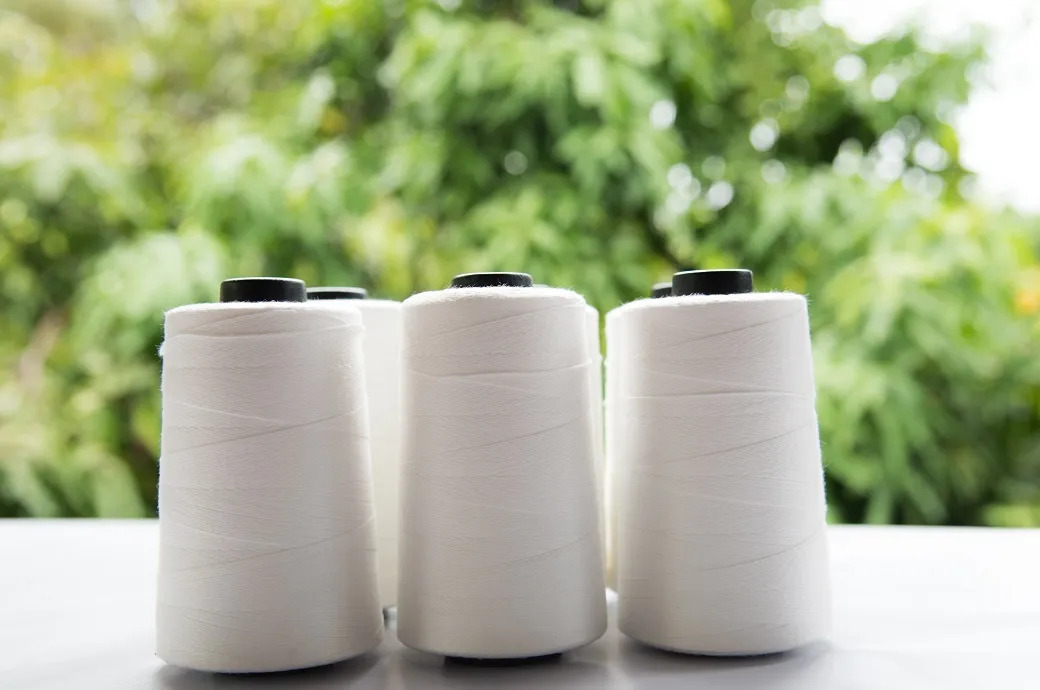
In a policy reversal that has given some relief across India’s textile ecosystem, the Ministry of Textiles has officially rescinded the Quality Control Order (QCO) on Viscose Staple Fibre (VSF) with immediate effect. Published in The Gazette of India on November 18, 2025, the order reverses the earlier mandate that required mandatory Bureau of Indian Standards (BIS) certification for all imported VSF.
The government notification was unequivocal. Acting under its statutory powers, and after consultation with BIS the Ministry stated that it “hereby rescinds the notification… dated 29th December 2022… relating to Viscose Staple Fibres with immediate effect.” This reversal marks more than just the removal of a compliance requirement. It signals a recalibration of India’s raw material policy in favour of global integration, lowered costs, and higher export competitiveness, a thread that ties directly into the nation’s Vision 2030 of achieving $100 billion in textile exports.
A policy reversal that rebalances market power
When the QCO on VSF came into effect in April 2023, it reshaped the MMF value chain in a way few anticipated. With BIS approvals delayed for most overseas suppliers, VSF imports fell sharply, effectively leaving the domestic industry dependent on a single local producer. The rescission disrupts that monopoly and opens the gates to global suppliers, reintroducing choice, competition, and supply flexibility.
Analysts view the move as part of a broader correction, coming on the heels of similar rollbacks on polyester intermediates reflecting the government’s evolving understanding that supply-side restrictions, however well-intentioned, can undermine cost competitiveness in export-led industries.
How VSF’s return to open markets alters MMF economics
Price Realignment: This is a correction long overdue. Before the rescission, domestic VSF commanded a 10-12 per cent premium over comparable grades from China, Indonesia, and Thailand. With imports now open, this price wedge will narrow quickly.
Table: Price dynamics before and after rescission
|
Metric |
Pre-rescission |
Post-rescission outlook |
What it means |
|
VSF Price Gap |
10-12% higher than imports |
Prices expected to converge toward global average |
Indian spinners gain breathing room—critical for yarn costs and export competitiveness |
|
Domestic Monopoly Pricing |
Supported by import restrictions |
Competition from multiple global suppliers |
Reduces raw material inflation and improves blending economics |
|
Impact on PSF |
VSF premium kept PSF more competitive |
Lower VSF prices will pressure PSF and P-V blends to adjust |
Entire MMF basket becomes more globally aligned |
The rescission of import restrictions marks a significant shift from a protected, high-cost domestic market to a competitive, globally aligned one.
• Cost relief: The elimination of the 10-12 per cent price premium on Viscose Staple Fibre (VSF) allows domestic prices to align with global averages, directly lowering raw material costs for Indian spinners.
• Market correction: The move effectively dismantles domestic monopoly pricing by introducing competition from international suppliers. This is expected to curb raw material inflation and make blended textiles (like Polyester-Viscose) more economically viable.
• Broader alignment: The price drop in VSF will likely force a price correction in Polyester Staple Fibre (PSF) and other substitutes to maintain competitiveness, resulting in a more efficient and globally competitive Man-Made Fibre (MMF) sector overall.
Demand revival as blends take centre stage again
Globally, MMF accounts for nearly 75 per cent of total fibre consumption, and India’s long-term growth strategy hinges on capturing a larger share of this market. VSF plays a crucial role in textile categories that demand breathability, drape, and comfort, qualities prized in womenswear, knits, home textiles, and fashion-forward products. With lower VSF prices spinners can revive dormant poly-viscose lines Mills can optimize blending ratios with cotton during volatile cotton price cycles. Exporters can re-enter markets where price competition from Bangladesh and Vietnam had grown fierce. This is particularly relevant for knitwear hubs like Tiruppur, Ludhiana, Kolkata et al and suiting clusters like Bhilwara, where VSF-based blends form the backbone of seasonal and value-added product lines.
Supply chain relief after a period of artificial constriction
One of the most significant benefits of the rollback is the restoration of an uninterrupted supply chain. During QCO enforcement imports from China, Indonesia, and Thailand were restricted; BIS approvals remained stuck in long bureaucratic cycles; import volumes crashed by 65 per cent within a year; spinners were forced to rely on a single domestic supplier and raw material inflation eroded export margins.
Table: Import and supply chain impact of the QCO
|
Metric |
Pre-rescission impact (VSF) |
Policy implication |
|
VSF Imports Decline |
Plummeted by 65% in less than a year after QCO enforcement (April 2023 onwards) |
Imports expected to surge as spinners secure raw material at competitive global rates |
|
Domestic Price Premium (VSF) |
10% - 12% over international prices |
Narrowing of the price gap, crucial for the cost structure of spinners and weavers |
|
VSF Import Sources Restricted |
Imports from key sources like China, Indonesia, and Thailand were restricted due to BIS licensing delays |
Wider access to foreign suppliers will enhance India's global competitiveness in MMF apparel |
The rescission rectifies significant supply side distortions that had previously hampered the industry. In fact, moving from a single domestic supplier to a diversified global base reduces the industry's vulnerability to domestic price shocks and supply constraints. The sharp drop in imports (65 per cent) had inflated costs, making Indian exports uncompetitive compared to rivals like Bangladesh and Vietnam. The policy reversal is expected to restore cost parity. And reinstating full access to Advance Authorization allows exporters to engage in long-term planning and pricing, which was previously difficult due to regulatory uncertainty and insufficient exemptions.
A lifeline for Indian exporters battling global rivals
Countries like Bangladesh, Vietnam, and Indonesia, India’s fiercest competitors in MMF-based apparel have long benefited from unrestricted access to low-cost VSF and polyester. The QCO-imposed cost premium acted as a penalty on Indian exporters, making it harder for them to compete in categories such as fashion knits, blended suiting, athleisure, viscose-rich womenswear and home textiles. With raw material costs now expected to normalize, India can reclaim lost competitive ground, especially in large global markets like the EU, Middle East, and the US.
What’s more, the timing is critical. Global buyers are actively diversifying sourcing away from China, and India is positioning itself as the world’s China+1 alternative. The rollback helps India enter this race with fewer handicaps.
No wonder, across associations spinners, weavers, powerloom clusters, garment exporters the reaction has been uniformly positive. The Ministry of Textiles stated that the move will “ensure seamless access to quality raw material, enhance global competitiveness, and drive industry-led growth.”
Industry bodies have labelled it as path-breaking, structural step forward and essential for India’s Vision 2030 targets. The common sentiment is that the rollback realigns India’s policy framework with market realities.
What this means for the Vision 2030 ambition
India aims to scale the textile sector from $160 billion today to $350 billion by 2030, including $100 billion in exports. To get there, two fundamentals are non-negotiable first is raw material security and second international price parity. The rescission of the VSF QCO checks both boxes as it reopens access to competitively priced global fibres and restores the momentum for MMF-based product diversification. It also strengthens India’s case as a reliable global sourcing partner while encouraging new investments in spinning, weaving, and fibre innovation. What’s most important is that manufacturing costs for MSMEs, the backbone of the textile chain also reduces with this move. And as the world shifts toward high-performance fabrics, technical textiles, and MMF-rich garments, India’s policy now aligns with the trajectory the global market is already on.
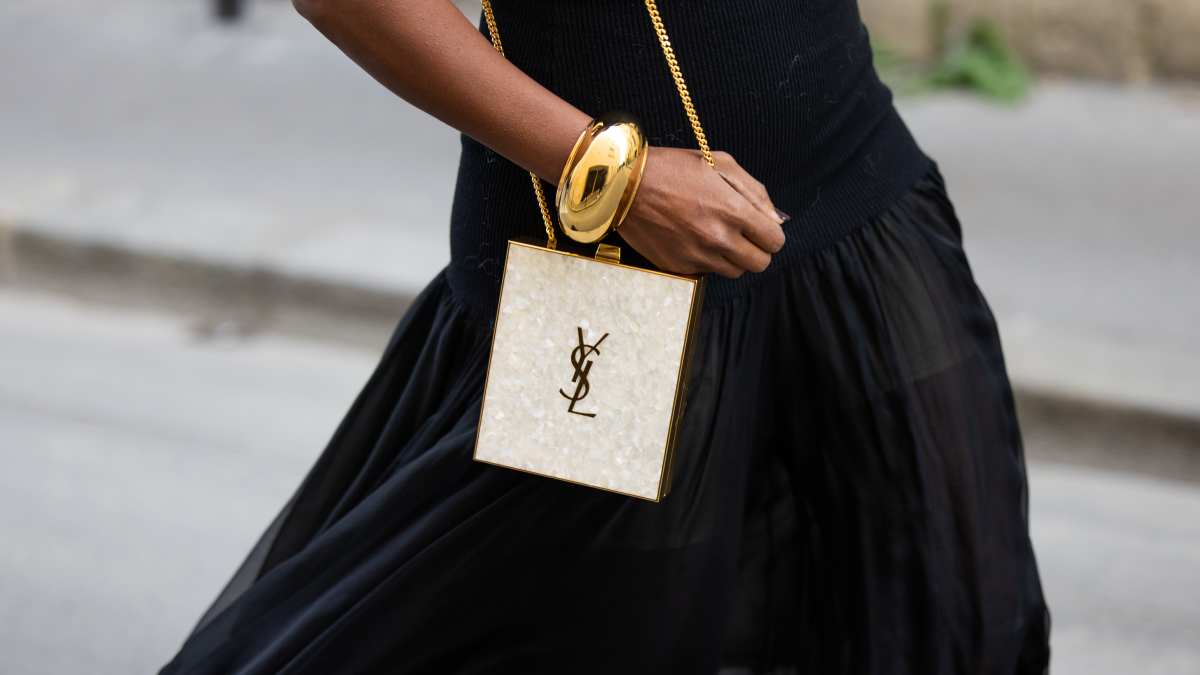
In a fashion industry often driven by noise viral micro-trends, rapid-fire drops, and overstated marketing the third quarter of 2025 delivered a surprising truth: quiet power is winning. Lyst’s Q3 Index, the global barometer of what consumers are searching, buying, and obsessing over, has crowned Saint Laurent the hottest brand in the world for the very first time.
This is not the rise of a disruptor, but the coronation of a brand that has spent years perfecting an aesthetic of restraint. As volatility rattles other luxury houses, brands anchored in clarity of purpose, those that understand who they are and who they serve are beginning to define the next era of luxury. The index’s latest results show the fashion sector settling into a new, more intentional rhythm. The brands thriving are those leaning into refined design, durability of style, and a kind of luxury that whispers rather than shouts.
A quarter of climbs, drops, and unexpected entrants
Below is the Q3 2025 top movement table, capturing the decisive swings in brand heat:
Table: Q3 2025 brand movements in the Lyst Index
|
Rank (Q3 2025) |
Brand |
Movement vs. Q2 2025 |
Key Driver/Finding |
|
1 |
Saint Laurent |
▲ 2 |
Tops the list for the first time. The Le Loafer was the quarter's second hottest product, reflecting high demand for sophisticated accessories. |
|
2 |
Miu Miu |
▼ 1 |
Still a powerhouse, but drops one spot. Continues to generate high buzz and product demand. |
|
3 |
COS |
▲ 4 |
The biggest climber in the Top 10. Saw a massive 147% increase in searches, proving the resonance of quality, understated basics across price points. |
|
4 |
The Row |
▲ 2 |
Demand up by 28% in the quarter. Their minimalist aesthetic and viral loafers solidify the continued "stealth wealth" trend. |
|
8 |
Loewe |
▼ 6 |
The biggest faller in the Top 10. Drops significantly after a strong run, despite a consistent focus on craft. |
|
13 |
Burberry |
▲ 4 |
Climbed four positions with a 14% lift in demand, showing positive signs from the brand's strategic repositioning. |
|
19 |
Stone Island |
New Entry |
Re-enters the index after four years, with a strong 115% quarter-on-quarter rise in demand, indicating a pull from casual subculture into the mainstream. |
The biggest story here is the divergence between brand clarity and brand volatility. Saint Laurent, The Row, and COS, each rooted in a distinct minimalist identity climbed. Loewe, known for boundary-pushing surrealism, dipped sharply. Meanwhile, Stone Island’s re-entry reveals that technical casualwear is cycling back into the global mainstream. The index suggests a marketplace rewarding consistency over chaos.
The rise of the quiet confidence consumer
A new kind of global luxury buyer is shaping the rankings. They are not hunting for logos or shock-value design. They want longevity, intentionality, and products that integrate seamlessly into a capsule lifestyle. Saint Laurent embodies this shift. Its ascent to No 1 wasn’t powered by spectacle, but by the Le Loafer, a product designed not to dominate a room, but to complete a wardrobe. It is minimal, sculpted, versatile, and built for repetition—not a one-season trend. Consumers are buying less, but buying better. The brands that understand this are rising.
High-street brand breakthrough
The remarkable jump by COS (from 7th to 3rd) highlights an important market dynamic: consumers are actively seeking high-quality, understated pieces at a more accessible price point. The brand's chunky cashmere sweater returned as one of Q3's hottest products, serving as an affordable gateway to the luxury aesthetic.
Table: COS's quarter at a glance
|
Metric |
Result |
|
Rank Movement |
+4 places |
|
Search Increase |
+147% |
|
Hero Product |
Chunky cashmere sweater (among hottest products globally) |
The numbers confirm COS’s role as the new gateway to luxury minimalism. At a time when shoppers are curating tighter wardrobes, its proposition sharp tailoring, clean silhouettes, premium basics feels both aspirational and attainable. This quarter, COS didn’t just rise in rank; it challenged the traditional boundaries of the luxury pyramid. Its growth shows a market where the definition of luxury is shifting from price tag to design philosophy.
An American revival
The Q3 Index also reveals a subtle but significant renaissance for American brands.
• Coach maintained its top-five strength, driven by a 29 per cent jump in demand and reinforced by sticky cultural moments around the Empire bag.
• Ralph Lauren, lifted by a resurgence of Americana aesthetics, climbed two spots to 9th spot.
• Even Madewell, outside the top 20, recorded a 34 per cent boost, reflecting a nostalgia-led discovery among Gen Z.
Together, these movements signal renewed global affection for American craftsmanship, storytelling, and classic style codes.
Interestingly, in this quarter, a single item often determined brand momentum: Saint Laurent’s Le Loafer didn’t just trend it shaped the brand’s ascent; COS’s cashmere sweater increased discovery at the high-street level; Skims, now at No 15, continues its meteoric path with product-led growth demand is up 271 per cent year-on-year, powered by category dominance in shapewear and solution-driven apparel. The index makes one thing clear: when the product is right, the consumer response is exponential.
COS's climb to the top three
COS (Collection of Style) moved up four 4 places to No 3 a 147 per cent increase in searches The success of COS is a clear case study in how quality basics and a consistent aesthetic can compete with traditional luxury houses. Positioning itself as a source for affordable luxury and a cornerstone for a versatile capsule wardrobe, the brand captured consumer attention who are "shopping with precision," balancing investment pieces with high-quality, accessible staples. Their strong search volume increase and the presence of their cashmere sweater on the hottest products list demonstrate a successful strategy of providing a modern, restrained aesthetic that aligns perfectly with the current preference for understated style.
The Lyst Index result is a uniquely dynamic snapshot of global fashion desire. Q3 2025 reflects a world in transition: away from maximalism, away from trend churn, toward a fashion economy shaped by deliberate choices. Thus this quarter marks an inflection point. Saint Laurent’s victory is symbolic not of dominance, but of discipline. Quiet luxury isn’t just a trend; it is becoming the backbone of modern fashion consumption. Brands that anchor themselves in clarity, craftsmanship, and consistency whether luxurious or accessible are reshaping the hierarchy of desirability.
In shor, the Lyst Index doesn’t simply show who’s winning. It shows why. And in Q3 2025, the winners were the brands that chose timelessness over noise
Spanish apparel brand Silbon has officially opened its inaugural U.S. store in Miami's Aventura Mall, using the high-profile location as a critical beachhead for an aggressive global growth trajectory. Historically focused on classic, medium-to-high segment menswear since its 2009 founding, the Córdoba-based firm is now strategically shifting toward its high-growth Woman and Kids lines, which are prominently featured in the new Miami store. This retail push is foundational to the company's financial outlook, with the plan targeting €94 million in turnover by 2025, projecting sales growth of over 44% from 2023’s €65 million.
Digital strategy and €180mn ambition
The U.S. entry, located near major competitors, is described by CEO Pablo López as "the biggest challenge we have faced." This high-stakes debut is part of a new strategic plan aiming for €180 million in sales by 2028. The strategy is underpinned by four core pillars: shifting capital expenditure toward digital channel investment for international markets, maturation of existing points-of-sale, scaling the Women’s line (which currently reports 60% annual growth), and multi-brand expansion. To appeal to conscious consumers, Silbon also highlights ethical commitments, including its "Second Life" circular economy program and the "Silbon Forest" reforestation initiative.
YKK Corporation, the world’s largest zipper and fastening manufacturer, has fundamentally restructured its global business strategy around an ambitious, science-backed Net-Zero commitment, marking a significant shift from incremental sustainability goals to full business transformation.
In its latest Integrated Report, the company confirmed its Net-Zero 2050 goal has been officially validated by the Science-Based Targets initiative (SBTi), requiring a 90% reduction in all Scope 1, 2, and 3 emissions by 2050.
YKK demonstrated immediate progress, announcing it has already cut Scope 1 and 2 emissions by 57% from its 2018 baseline. This achievement was largely driven by rapidly boosting renewable energy to 61.2% of its total consumption, with 45 global sites, including the entire China region, now running on 100% renewable power.
The new "ONE YKK Vision" emphasizes deep supply chain action and circularity. The company increased its use of sustainable materials to 48% and is driving innovation with new products like NATULON Plus and Revived Renewal Components, designed for easier garment-to-garment recycling and repair.
"Sustainability is not a slogan—it’s a strategy,” said Koichi Matsushima, President, YKK Corporation. “With our Net-Zero commitment... we are taking bold steps to transform our business, empower our people, and lead the way toward a circular economy.” The plan underscores the company's commitment to climate, material resource efficiency, and chemical safety across its entire value chain.
The global fashion and apparel industry is set for another "challenging" year, with a projected continuation of low single-digit growth in 2026. This sluggish financial outlook, attributed to persistent macroeconomic volatility and heightened consumer caution, is compelling apparel brands to radically redefine their operating models.
Consumer caution drives value shift
McKinsey & Company analysis indicates that global industry growth will remain constrained, underpinned by exceptionally low consumer sentiment, particularly in the United States, where figures hit lows not seen since May 2020. This caution translates into a fierce consumer shift toward value: over 60% of global shoppers are actively seeking ways to reduce fashion expenses, driving significant growth in the secondhand market. The apparel sector’s response is the "Elevation Game," where mid-market brands are investing in product quality and experience to capture shoppers squeezed out of aspirational luxury segments.
Efficiency unlocked by automation
To counter the growth stagnation and manage rising operational costs, such as the projected 9% increase in clothing prices due to tariffs and supply chain reconfiguration,companies are prioritizing operational efficiency. Artificial Intelligence (AI) is moving from an optional tool to a business necessity for cost control. Generative AI is being deployed across functions like content creation and customer service to drive productivity gains, freeing up resources for innovation. This push for efficiency, rather than pure expansion, is the central plank of the industry’s strategy to navigate the slow-growth environment and emerge as "agile winners."
The State of Fashion 2026 report is an annual strategic analysis produced by McKinsey & Company and The Business of Fashion (BoF), setting the agenda for industry leaders by tracking economic performance, growth sectors , and emerging technological and regulatory shifts.
The premier trade fair for technical textiles, non-wovens, and composites, Techtextil India 2025, commenced today, November 19, 2025, at the Bombay Exhibition Centre in Mumbai, marking its 10th edition. Organized by Messe Frankfurt Trade Fairs India, the event runs until November 21, 2025. This landmark edition connects 215 exhibitors, including 100 first-time exhibitors, to the textile value chain. The show’s dynamic agenda features over 300 brands, showcasing innovations across 12 application-based textile segments. Visitors are offered ample engagement and networking opportunities to discover next-generation solutions and deepen partnerships at this vital B2B event.
Focus on MMF, sustainability, and India's global role
Dignitaries emphasized the growing significance of man-made fibres (MMF) and the need for sustainability. R Lalitha, IAS, opined that the expo weaves together leading innovators, policymakers, and companies to frame appropriate policies for the growing industry. She also stated her belief that man-made fibres is the sunrise sector in the future and that concepts like sustainability and circularity will give rise to better technology that could help speed up research and development in India. On the milestone occasion, Raj Manek commented that the Indian textile industry is witnessing a remarkable transformation driven by government support, technological innovation, and global demand for sustainable materials. He added that Techtextil India 2025 will not only showcase the latest in technical textiles and nonwovens but also serve as a knowledge-driven hub connecting policy with practice. Manek concluded that the synergy between government initiatives and industry platforms like Techtextil India 2025 will continue to strengthen India’s leadership in the global textile landscape, weaving together innovation, collaboration, and opportunity.
Expo highlights and industry support
The 10th edition is recognized as a significant platform for innovation, strategic networking, and opportunity creation for the technical textile sector. The opening day has already experienced robust participation, energized discussions, and promising collaboration. The three-day event will feature in-depth knowledge sessions under the Techtextil Symposium. Topics will range from new avenues for technical textiles and sustainable textiles to India’s activewear future, exploring circular supply chains, and fabrics from waste. Event highlights include a dedicated Sporttech Pavilion and a German Pavilion featuring 13 brands. The expo has garnered support from key industry bodies, including the Manmade & Technical Textiles Export Promotion Council (MATEXIL) and the Indian Technical Textile Association (ITTA). The Department of Textiles (Government of Maharashtra) and the Government of Tamil Nadu are also supporting the event, with Tamil Nadu serving as the Partner State. Techtextil India is part of Messe Frankfurt’s Texpertise Network.
Distinguished dignitaries and industry vision
The show was inaugurated in the presence of distinguished dignitaries. The list included the Guest of Honour, Honourable R Lalitha, IAS, Director of Textiles, Department of Textiles, Government of Tamil Nadu. Other key figures present were Pramod Khosla, Member of Committee of Administration, The Manmade and Technical Textiles Export Promotion Council (MATEXIL), andMahesh Kudav, Chairman, Indian Technical Textiles Association. Messe Frankfurt representatives included Sabine Scharrer, Director, Brand Management, Technical Textiles and Textile Processing, Messe Frankfurt GmbH, and Raj Manek, Executive Director & Board Member, Messe Frankfurt Asia Holdings Ltd.
The world's largest fibre innovation congress, the Dornbirn Global Fibre Conference (GFC) Asia, made a landmark debut in Mumbai this week, positioning sustainability and circularity as the critical engines for India's ambitious textile growth. Held under the umbrella of the Techtextil India Symposium 2025, the conference, themed ‘Shaping the Future: Sustainable Growth in Fibre Solutions and Innovations’, served as a high-level platform for global experts to converge with India's vibrant textile sector.
The event established a direct link between global-standard fibre innovation and India’s urgent national target: elevating its textile and apparel exports to USD 100 billion by 2030. The path to this goal, as highlighted by the conference, runs directly through embracing man-made fibres (MMF), technical textiles, and, most crucially, closing the loop on textile waste.
The $100 bn imperative and the MMF shift
India, traditionally a powerhouse in natural fibres like cotton, is now at a "transformative juncture" that demands a strategic pivot toward innovation. The shift is not just about increasing volume but diversifying into higher-value technical textiles, which have diverse applications in areas like automotive airbags, hygiene products (e.g., baby diapers), and more.
“India is becoming an epicentre of man-made fibre and the circular supply chain into yarn,” stated Bhadresh Dodhia, Co-Chairman of the Bharat Tex Committee 2025. This pivot is essential for achieving the export goal, cementing India's place as a global hub for technical textiles.
The Critical Challenge: Turning waste into a raw material
While the vision for a 'greener, smarter, and more resilient textiles future' is clear, the conference laid bare a significant challenge—and a massive opportunity—in recycling.
Regarding The Recycling Gap, in India, textile-to-textile recycling is currently below 1%. However, Dodhia did not view this as a gap, but as a "big opportunity to harness this huge pile of waste that has the potential to be the raw material” for the industry.
The discussions emphasized that success hinges on implementing circular economy practices. This includes adopting technologies for collection and sorting to efficiently make feedstock available for the circular supply chain to work efficiently. India is already taking positive steps, leading many developed countries in converting post-consumer waste, such as recycling bottles into yarn and plastic. Furthermore, the implementation of Extended Producer Responsibility (EPR) for plastic waste could significantly speed up the recycling of plastic waste into fibres, helping India realise its potential to become a recycled polyester hub.
Collaboration: The key to unlocking potential
The Government of Tamil Nadu—a state already established in natural fibres—supported the event as a Partner State. Hon’ble Ms. V Amuthavalli, IAS, Secretary – Handlooms, Handicrafts, Textiles and Khadi, Government of Tamil Nadu, highlighted the strategic exchange: “Being a Partner State to the Dornbirn GFC Asia, we are looking towards exchanging knowledge and building Tamil Nadu’s technical textiles industry as well,” emphasizing the need to diversify more into man-made fibres as well.
The industry's ability to embrace change, drive innovation and foster cross-sector collaboration will define its success. As Murugan Thenkondar, President – Marketing & Global Head – Business Development, Aditya Birla – Grasim Industries Limited – Birla Cellulose, noted, this platform is "good for India as it will bring a lot of outside perspective in India".
Uday Paul Singh Gill, Senior Partner, Gherzi Consulting, and Guest of Honour, emphasized the global context, “I believe that there is a huge potential in the Indian industry with diverse applications in baby diapers, automotive airbags, hygiene and more. Globally, circularity, sustainability and AI will impact industry."
The conference, which featured industry leaders like Birla Cellulose, Lenzing, and Oerlikon, ultimately served as a "seminal platform" to propel India's textiles sector into a new era where sustainability and digital transformation are no longer optional. They are essential for maintaining competitiveness.
The Dornbirn GFC Asia, a collaboration between Messe Frankfurt Trade Fairs India and the Austrian Fibers Institute, was designed to bring in this essential global expertise.

On October 29 and 30, the marble halls of Cipriani South Street became the nerve center of a global fashion industry at an inflection point. At the annual ‘WWD Apparel & Retail CEO Summit’, executives from the world’s most influential brands gathered against a backdrop of economic volatility, geopolitical disruptions, and the relentless acceleration of technology. This year’s theme: The Power of Resilience, was less a slogan and more a survival blueprint.
Across two days of rigorous discussions and a star-studded Honors gala, one message rose above the rest: the fashion industry must shed old operating systems and embrace a future defined by data intelligence, AI-powered agility, and a reinvention of corporate culture.
Fashion’s reckoning with redundant data
If there was one topic that dominated the summit, it was the silent yet staggering cost of inefficient data management. In the keynote, ‘Escape the Data Trap’, executives confronted an industry-wide problem that has long been hidden in plain sight: the massive duplication of product information.
Research presented at the summit revealed that nearly 89 per cent of product data across brands is identical a redundancy that collectively drains over $100 billion annually through repeated formatting, cleansing, and manual entry. Executives described this not as an IT issue, but a structural roadblock to creativity and growth. “Agility isn't just fast fulfilment, it’s freeing teams from data drudgery so they can make decisions that matter,” one leader said, distilling the urgency of the moment. In a business that prizes speed, personalization, and trend responsiveness, the industry can no longer afford a back-end clogged with copy-and-paste inefficiencies.
From hype cycle to hard ROI
While technology has long been a buzzword at CEO summits, this year marked a turning point. The conversations around generative AI shifted from possibility to profitability. Oz Saar, Chief Innovation Officer at Steve Madden, outlined a near-future where generative AI will sit at the core of product development, forecasting, and supply chain orchestration. According to projections shared at the summit, AI adoption in retail, currently in the single digits is expected to grow to nearly 50 per cent by 2030.
This is not theoretical optimism. Retailers are already using AI to shorten design cycles from months to days; reduce supply chain forecasting errors; automate SKU-level decision-making; personalize consumer journeys at scale
The takeaway was unequivocal: brands that treat AI as an optional tool will fall behind; those that treat it as a strategic co-pilot will define the next decade of retail profitability.
Culture as the ultimate shock absorber
If data and AI dominated the daytime sessions, the evening conversations turned toward the less tangible but equally critical pillar of resilience: corporate culture. Executives from Neiman Marcus Group emphasized a guiding philosophy of ‘leading with love’, a surprisingly human-centric mantra in a luxury sector fighting headwinds. For them, resilience is not just financial stamina; it's emotional intelligence, empathy, and internal trust.
Meanwhile, e.l.f. Cosmetics shared how its culture of “healthy conflict and accountability” paired with issuing equity to every employee has created a workforce where ownership is literal, not metaphorical. The brand’s meteoric rise, executives argued, is inseparable from the cultural fabric behind it. The summit made clear that in an industry shaped by macro disruptions, culture is no longer soft strategy, it is infrastructure.
Leadership on the frontlines
The summit’s roster of speakers read like a who’s who of modern retail influence, each offering a window into the frontline challenges of brand reinvention. In the session ‘Reinventing an American Icon’, Richard Dickson detailed his ongoing mission to revive Gap Inc. It is, at its heart, an exercise in disciplined simplification cutting noise, sharpening brand identity, and rediscovering the authenticity that once made the label a cultural symbol. His message resonated with an industry grappling with the burden of heritage in a hyper-modern world: reinvention begins with clarity. In Forging a Resilient Future’, PVH Corp. CEO Stefan Larsson and Narvar CEO Anisa Kumar argued that supply chain transparency and post-purchase experiences now carry as much weight in consumer loyalty as product design. As customers grow more informed, the end-to-end brand experience becomes a critical differentiator.
Founders Margaret and Katherine Kleveland of the Californian label Dôen, loved for its mission-driven ethos shared the unique balancing act of scaling a boutique brand without diluting its values. Their session, ‘Testing the Limits’ underscored how creative integrity and operational rigor must move in lockstep.
In ‘Navigating Opportunities in Fashion’ designer Narciso Rodriguez offered a perspective on creative endurance. Against the churn of micro-trends and social media cycles, he argued that the only viable path for designers is to protect their creative core while adapting to technology-driven change.
The summit culminated with the annual Honors gala a celebration not just of commercial achievement, but of leadership that models resilience. The prestigious John B. Fairchild Honor went to Brunello Cucinelli, the Italian designer whose luxury empire is built on craftsmanship, human dignity, and a philosophy of ‘humanistic capitalism’. It was a recognition of a business that has consistently defied industry turbulence.
Other honorees included: Fran Horowitz, CEO, Abercrombie & Fitch; Tory Burch, Executive Chairman & CCO; Todd Snyder, Founder & President; Naiomi Glasses, Artist-in-Residence, Polo Ralph Lauren; Luxury houses Bulgari and Boucheron; digital native disruptor Bubble Skincare; design-led brand Dôen. Collectively, the honorees represented a cross-section of the industry’s future craftsmanship, creativity, cultural relevance, and digital-native agility.
In a major policy reversal to support the textile industry's global competitiveness, the Ministry of Textiles has immediately rescinded the Quality Control Order (QCO) on Viscose Staple Fibres (VSF). The notification, published on November 18, 2025, reverses the 2022 order that mandated Bureau of Indian Standards (BIS) certification for VSF imports. This strategic move, following a similar rollback for the polyester value chain, directly addresses the industry’s concerns over high raw material costs and supply constraints.
Price war and supply chain relief
The QCO had acted as a non-tariff barrier, granting a 10-12% price premium to the sole domestic VSF producer and causing imports to plummet by 65% since April 2023. The market re-opening will facilitate an immediate inflow of cheaper VSF from global suppliers like China and Indonesia, forcing a convergence of domestic prices with international rates. As VSF—the second-largest Man-Made Fibre (MMF)—becomes cheaper, it increases the competitive pressure on Polyester Staple Fibre (PSF) and makes Poly-Viscose (P-V) blends more cost-effective for garment manufacturers. The overall reduction in MMF costs is expected to significantly improve the global cost competitiveness of Indian textiles, aligning with the Vision 2030 goal of achieving $100 billion in textile exports.
Industry leaders have hailed the decision as a "path-breaking reform," critical for ensuring seamless access to raw materials and driving growth toward the government's target of a $350 billion textile business.
The Rajasthan State Industrial Development and Investment Corporation (RIICO) has granted an administrative approval of approximately $25.0 million (₹221.03 crore) for the development of the Roopaheli Textile Park in Bhilwara. This significant investment is being hailed as a critical step to transition the 'Textile City' from merely a production hub to a state-of-the-art integrated manufacturing and export center, specifically focusing on its dominant synthetic and technical textile segments.
Phasing out bottlenecks with a new Mega-Park
The sanctioned funds are earmarked for developing the new park over 12.48 lakh sq. meters in Hurda Tehsil, providing 181 industrial plots. The plan includes essential infrastructure like fire stations, skill development centers, and common facilities to consolidate spinning, weaving, processing, and garment production. Bhilwara, historically known as a major producer of PV (Polyester-Viscose) fabrics, currently operates around 1,000 textile units with an estimated annual turnover of approximately $2.82 billion (₹25,000 crore), exporting synthetic yarn and fabrics globally. The new park aims to address long-standing challenges such as high electricity costs and the need for modern infrastructure, which the industry has consistently raised in pre-budget demands.
Resilience and the Technical Textile future
Despite global slowdowns and post-pandemic challenges like supply chain disruptions, Bhilwara's textile sector has historically demonstrated resilience, with an annual growth rate averaging 8-10% before major economic shifts. The city accounts for 47% of Rajasthan’s net value added in textiles. A key growth driver is the expansion into technical textiles—fabric used for functional, non-apparel purposes like military tents and industrial applications—a segment where local players are actively diversifying.
Big companies such as Bhilwara Technical Textiles Limited (BTTL), which focuses on this specialized segment, highlight the market potential. While smaller firms face profitability pressures, their presence underlines the strategic shift toward high-value, niche products. This RIICO investment is seen as crucial for providing the supportive ecosystem required for this next phase of value-added manufacturing and realizing the industry's full export potential. This video provides an update on the $25.0 million sanction for the Roopaheli Textile Park in Bhilwara.

